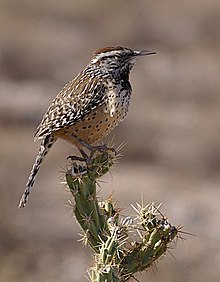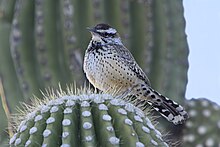Cactus wren
| Cactus wren | |
|---|---|
 | |
Conservation status | |
 Least Concern (IUCN 3.1)[1] | |
Scientific classification | |
| Kingdom: | Animalia |
| Phylum: | Chordata |
| Class: | Aves |
| Order: | Passeriformes |
| Family: | Troglodytidae |
| Genus: | Campylorhynchus |
| Species: | C. brunneicapillus |
Binomial name | |
Campylorhynchus brunneicapillus Lafresnaye, 1835[2] | |
 | |
| Distribution map of the cactus wren. | |
The cactus wren (Campylorhynchus brunneicapillus) is a species of wren that is native to the southwestern United States southwards to central Mexico.
Contents
1 Diet
2 Habitat
3 Behavior
4 State bird
5 Gallery
6 References
7 External links
Diet
The cactus wren primarily eats insects, including ants, beetles, grasshoppers, termites[3] and wasps. Occasionally, it will take seeds, fruits, small reptiles and frogs. Foraging begins late in the morning and is versatile; the cactus wren will search under leaves and ground litter and overturn objects in search of insects, as well as feeding in the foliage and branches of larger vegetation. Increasing temperatures cause a shift in foraging behavior to shady and cooler microclimates, and activity slows during hot afternoon temperatures. Almost all water is obtained from food, and free-standing water is rarely used even when found.
Habitat

At nest in Desert Botanical Garden, Phoenix AZ
It is a bird of arid regions, and is often found around yucca, mesquite or saguaro; it nests in cactus plants, sometimes in a hole in a saguaro, sometimes where its nest will be protected by the prickly cactus spines of a cholla or leaves of a yucca.
Behavior
The cactus wren forms permanent pair bonds, and the pairs defend a territory where they live all through the year.
In residential areas, cactus wrens are notorious for getting into mischief. Being curious birds, it is not uncommon for them to be found flying about out-of-place in automobiles or homes where a window has been left open.
State bird
The cactus wren is the state bird of Arizona.
Gallery
Nesting in Desert Botanical Garden Phoenix, Arizona

in Tucson

in Sabino Canyon, Arizona

Juvenile, Phoenix
References
^ BirdLife International (2012). "Campylorhynchus brunneicapillus". IUCN Red List of Threatened Species. Version 2013.2. International Union for Conservation of Nature. Retrieved 26 November 2013..mw-parser-output cite.citationfont-style:inherit.mw-parser-output qquotes:"""""""'""'".mw-parser-output code.cs1-codecolor:inherit;background:inherit;border:inherit;padding:inherit.mw-parser-output .cs1-lock-free abackground:url("//upload.wikimedia.org/wikipedia/commons/thumb/6/65/Lock-green.svg/9px-Lock-green.svg.png")no-repeat;background-position:right .1em center.mw-parser-output .cs1-lock-limited a,.mw-parser-output .cs1-lock-registration abackground:url("//upload.wikimedia.org/wikipedia/commons/thumb/d/d6/Lock-gray-alt-2.svg/9px-Lock-gray-alt-2.svg.png")no-repeat;background-position:right .1em center.mw-parser-output .cs1-lock-subscription abackground:url("//upload.wikimedia.org/wikipedia/commons/thumb/a/aa/Lock-red-alt-2.svg/9px-Lock-red-alt-2.svg.png")no-repeat;background-position:right .1em center.mw-parser-output .cs1-subscription,.mw-parser-output .cs1-registrationcolor:#555.mw-parser-output .cs1-subscription span,.mw-parser-output .cs1-registration spanborder-bottom:1px dotted;cursor:help.mw-parser-output .cs1-hidden-errordisplay:none;font-size:100%.mw-parser-output .cs1-visible-errorfont-size:100%.mw-parser-output .cs1-subscription,.mw-parser-output .cs1-registration,.mw-parser-output .cs1-formatfont-size:95%.mw-parser-output .cs1-kern-left,.mw-parser-output .cs1-kern-wl-leftpadding-left:0.2em.mw-parser-output .cs1-kern-right,.mw-parser-output .cs1-kern-wl-rightpadding-right:0.2em
^ "Campylorhynchus brunneicapillus". Integrated Taxonomic Information System. Retrieved 9 February 2006.
^ Atlas of World Wildlife. Galley Press. p. 28.
External links
| Wikimedia Commons has media related to Campylorhynchus brunneicapillus. |
Wikispecies has information related to Campylorhynchus brunneicapillus |
Cactus Wren videos (Tree of Life)
Cactus Wren videos on the Internet Bird Collection
Stamps (for Mexico, United States) with RangeMap
Cactus Wren photos VIREO




